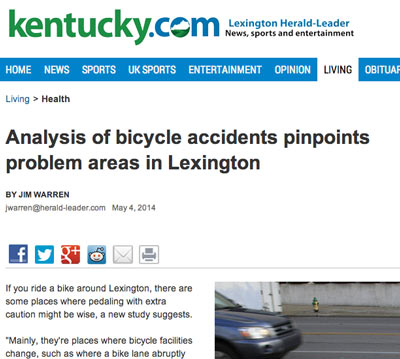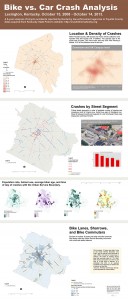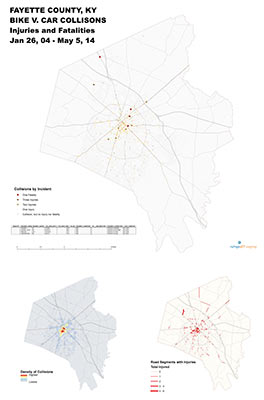
Article by Jim Warren, Herald-Leader, May 4
If you ride a bike around Lexington, there are some places where pedaling with extra caution might be wise, a new study suggests.
“Mainly, they’re places where bicycle facilities change, such as where a bike lane abruptly ends. They seem to be the trouble spots,” said Boyd Shearer, a University of Kentucky geographer who led the study of bike-vehicle collisions in Lexington.
Shearer and some of his students recently studied 396 collisions between bikes and other vehicles that occurred on Lexington streets and roads from October 2008 through October 2013. The five-year list included 293 wrecks that caused injuries and three that resulted in fatalities.
After collecting wreck data from police reports, the researchers analyzed the results using a computerized mapping system called GIS that can reveal underlying relationships, patterns and trends.
“I thought it would be an interesting project to do, and that it might help the city,” Shearer said.
A bicyclist himself, Shearer has worked with Lexington planners on other bike-related projects.
He said the new study shows the area around UK had the greatest concentration of bike-versus-car wrecks. That’s not surprising, he said, given the large number of students who ride on campus.
Perhaps more surprising was that 25 percent of the riders involved in collisions during the five-year period weren’t wearing helmets. Another surprise: 21 percent of the accidents were hit-and-runs.
Most notable overall, he said, was that riders often got into trouble in places where bike lanes ended abruptly.
“The bike rider is rolling along in a lane by himself, and that lane suddenly ends,” Shearer said. “You never win against a car if you’re on a bike.”
One such spot, according to Shearer, is near where Winchester Road, East Third Street and Midland Avenue come together. A bike lane along Winchester Road ends at Walton Avenue, and an extra traffic lane for cars opens up between Walton and Midland, he noted.
“Bikers kind of get squeezed,” Shearer said.
He and his students also identified “critical segments” of four streets — mostly near UK — with high numbers of bike-car crashes during 2008-13.
They were: South Limestone north of Virginia Avenue, six wrecks; Euclid Avenue east of Woodland Avenue, five; Winchester Road near East Third Street, four; Rose Street from Euclid to Columbia avenues, four; and Rose from Columbia to Huguelet Drive, three.
Ultimately, Shearer said, he hopes to see Lexington’s bike trails linked together, which would allow riders to bike long distances sheltered from vehicular traffic.
“The Town Branch Trail isn’t connected yet,” he said. “But if it reaches downtown and the Legacy Trail is linked with it, riders could use them in lieu of streets to get in and out of downtown, not just for recreation but for real bike commuting.”
Scott Thompson, Lexington’s bike and pedestrian coordinator, said planners were looking at ways to “separate bicyclists from traffic,” whether that’s through more bike lanes or putting small barriers between bike and traffic lanes.
Jim Warren: (859) 231-3255.
Read more here: http://www.kentucky.com/2014/05/04/3227487/analysis-of-bicycle-accidents.html#storylink=cpy







Leave a Reply